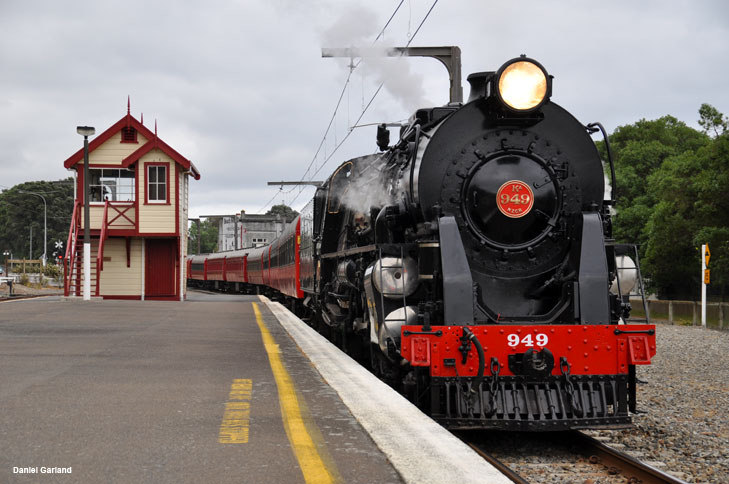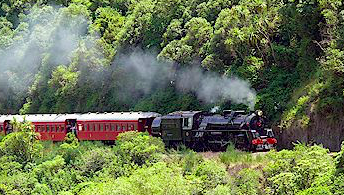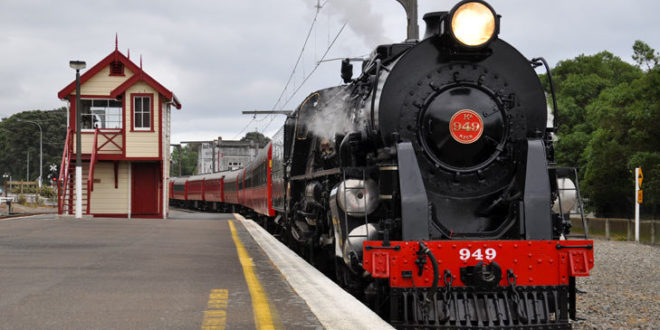OPINION: Steam engines still have that special aura to them and that is celebrated by enthusiasts all over the country. In Kapiti that means “Steam Incorporated” and they run steam engine excursions all over the lower North Island, both to make money to fund what they do and because of the fun of it.
Last Saturday my wife and I went on the excursion to Taihape and back. It was a full day starting at 7.45am at Paekakariki Station and finishing at the same point at about 8.30 at night. We were lucky that the weather was good so we saw everything. These excursions are popular – I can’t recall seeing any empty seats. We were warned that because the carriages were unheated it would get cold but it was mild and our warm jackets stayed on the rack.
There is no doubt that steam engines are cool pieces of machinery – made in an era when all the working bits stuck out so you could see what was going on and masses of smoke and steam to add to the drama. The engine that pulled out train was named the “Passchendaele” in memory of that WWI battle.
 Steam engines run on fuel (in this case coal) and lots of water (to make the steam, in the boiler). We watered a couple of time on the outward journey and the test of when the water tank was full was simply that the tank overflowed in all directions. Also, dedicated water tanks are now largely a thing of the past so good use was made of local fire hydrants.
Steam engines run on fuel (in this case coal) and lots of water (to make the steam, in the boiler). We watered a couple of time on the outward journey and the test of when the water tank was full was simply that the tank overflowed in all directions. Also, dedicated water tanks are now largely a thing of the past so good use was made of local fire hydrants.
For most of the journey we were paralleled by a truck which carried a load of the coal we would burn on the return to civilisation. Yes – you really do have to be self-sufficient in this business. My own memory of a youngster is of how dirty steam trains were and coming off at the end of a trip with a liberal covering of smoke and grime. But I must say this trip was surprisingly clean and we could have been travelling in a modern train for all the dirt we got. Maybe the wind was in the right quarter!!
We started dead on time and the first few stops were interesting, a good way of getting in the mood but mainly to take on board the full complement of passengers. Seeing a country from a train is like peeking in the back door – all the messy bits are exposed which is half the fun of it.
The really interesting part of the journey began when we left Marton for the final pull up the gradient to Taihape. On the way, we passed over the large viaducts which are famous in this part of the track – all at “tourist speed” to give plenty of time for photos. These viaducts enable the track to criss-cross the Rangitikei River gorge. Then there was a change to jump off the train, so it could back up and give the passengers a chance to photograph the train charging down the line. As well as photographing the train it was quite a spectacle to see the local paddock thick with photographers all ready to take their shot. We did this once on the way up to Taihape and once on the way back.
Then it was into Taihape for a bite of lunch before the return journey.
I can tell you that Taihape on a Saturday afternoon does not have much to recommend it! It is really a typical country town, taking all of ten minutes to stroll leisurely from one end of the main street to the other. Most of the stores were closed although there were enough cafes and so on open for everyone to get a bite to eat.
Then it was back on the train for the return journey – really seeing everything again backwards, which I guess is the merit of doing round trips like the one through the Manawatu Gorge rather than up and down the same piece of track.
 Those of us who had ordered dinner looked for this when we rolled into Palmerston North at about 6 pm. It was all part of the fun but typical New Zealand for all of that. The food arrived late (at least 5 minutes after the train), we had a minimal choice (the main meal turned out to be a surprisingly good lasagne) and we struggled to manage our meals out of plastic bags and with containers on out laps.
Those of us who had ordered dinner looked for this when we rolled into Palmerston North at about 6 pm. It was all part of the fun but typical New Zealand for all of that. The food arrived late (at least 5 minutes after the train), we had a minimal choice (the main meal turned out to be a surprisingly good lasagne) and we struggled to manage our meals out of plastic bags and with containers on out laps.
By now we were on the final lap and I suspect running a bit behind the desirable timetable – a couple of times on the way up we had to pull into a loop while a freight train thundered past. There were no stops like that on the final stretch but you could feel the engine really “stretching its legs”: and going full tilt. The really tricky bit is re-entering the zone where the electric commuter trains run because they have the first choice of the line. We dropped off passengers at several stations past Palmerston (Levin, Otaki, Fielding, Paraparaumu) finally rolling into Paekakariki at about 8:30 pm or so – with a warning that the train needed to be vacated quickly as the local commuter units would be along in about 7 minutes’ time. And that was it! A really enjoyable day and a real journey into the past.
Perhaps the most enduring memory of the trip – maybe every steam engine trip – is the unique and mournful and sometimes haunting sound of the steam whistle. Played like an instrument on every excuse – empty stations, passing trains, level crossings and so on – sometimes I suspect just for the hell of it!. Unique!
By Bas Walker
This is another of Bas Walker’s posts on GrownUps. Please look out for his articles, containing his Beachside Ponderings.









Join the Discussion
Type out your comment here:
You must be logged in to post a comment.